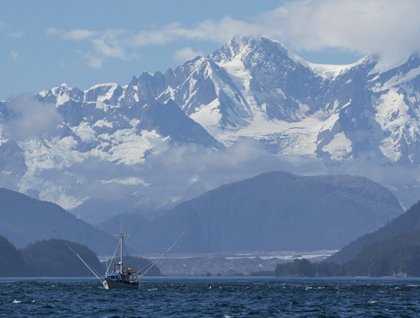The ocean this morning seemed to be a live organism, the big swells crashing against the rocks looking like its heartbeat. Back and forth, the western shoreline of George Island covered with white water as the pulsating ocean kissed it repeatedly as the National Geographic Sea Lion approached. A light rain and gray skies contributed to the whole scene and made for truly appropriate southeast Alaska weather. After dropping the anchor off the eastern side of George Island we explored it by foot, kayak, expedition landing craft and, in my case, SCUBA diving. Those who went ashore got the chance to admire the nice trails in the forest and the site of a former WWII gun. During those turbulent years, American soldiers kept guard of the waters around George Island looking for enemy submarines trying to enter the northern portion of the Inside Passage. Nowadays, the only vessels that the old rusty gun sees are commercial fishing boats, sport fishing craft or expedition ships. By mid-morning the rain stopped and blue portions of the sky could be seen above. The kayakers had the opportunity to get up close and personal with many of the marine creatures who call this place home, including sea otters, common murres and black-legged kittiwakes. Meanwhile, those who chose to explore the coastline by expedition landing craft enjoyed the same creatures plus the chance to see a larger portion of the island. And my dive buddy Cassidy O’Bryant and I got video documentation of many of the creatures that live beneath the waves off George Island, including golden nudibranchs, velcro stars, decorator and Puget Sound king crabs, among many others.
By the time we were all back on board the weather had changed dramatically and the sun was shining over a clear blue sky, amazing! During lunch the ship traveled to a small archipelago nearby called the Inian Islands. The Inians are located between the large Chichagof Island and the Fairweather Range in mainland Alaska, right where the waters of the Gulf of Alaska flow in and out of the northern portion of the Inside Passage. Their presence creates a bottleneck and accelerates the tidal currents around them, making for an abundance of wildlife; Steller’s sea lions, sea otters, harbor porpoises, pigeon guillemots, common murres and marbled murrelets were seen during our afternoon explorations. The Steller’s sea lions were the stars of the day, not only for their impressive size and great numbers, but for their constant play-fighting and arguing to each other trying to be “the king of the hill.” Some of the beautiful mountains of the Fairweather Range, perhaps the tallest coastal mountain range in the world, were clearly seen to the north and made for a spectacular background of another great day in southeast Alaska.







